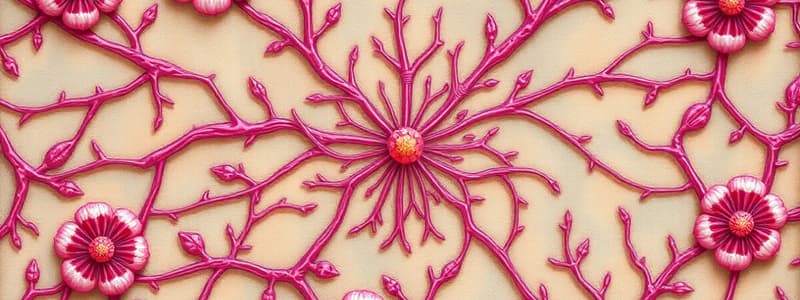Podcast
Questions and Answers
Which type of epithelial tissue is characterized by a single layer of tall, column-like cells?
Which type of epithelial tissue is characterized by a single layer of tall, column-like cells?
- Simple cuboidal epithelium
- Pseudostratified epithelium
- Stratified squamous epithelium
- Simple columnar epithelium (correct)
What is the primary structural feature that distinguishes adipose tissue from other types of connective tissue?
What is the primary structural feature that distinguishes adipose tissue from other types of connective tissue?
- Presence of adipocytes (correct)
- High density of collagen fibers
- Elastic fibers
- Fluid matrix
Which type of muscle tissue is characterized by voluntary control and striations?
Which type of muscle tissue is characterized by voluntary control and striations?
- Smooth muscle
- Myocardium
- Cardiac muscle
- Skeletal muscle (correct)
What structure separates the outer layer of bone from the bone tissue itself?
What structure separates the outer layer of bone from the bone tissue itself?
Which type of blood vessel is primarily responsible for transporting oxygenated blood away from the heart?
Which type of blood vessel is primarily responsible for transporting oxygenated blood away from the heart?
Flashcards
Epithelial Tissue
Epithelial Tissue
Specialized tissue that covers body surfaces, lines cavities, and forms glands. It's characterized by tightly packed cells with minimal intercellular space and a basement membrane separating it from underlying connective tissue.
Connective Tissue
Connective Tissue
Connective tissue is diverse, found throughout the body, and is responsible for supporting, connecting, and protecting other tissues. It's characterized by cells embedded in a matrix, which is a non-living substance that varies in composition.
Cartilage
Cartilage
A type of connective tissue that provides structural support and flexibility. It's found in joints, ears, nose, and trachea. There are three types: hyaline, elastic, and fibrocartilage.
Bone
Bone
Signup and view all the flashcards
Muscle Tissue
Muscle Tissue
Signup and view all the flashcards
Study Notes
Epithelial Tissue
- Epithelial tissue forms linings and coverings, often with specialized functions.
- Classified based on cell shape (squamous, cuboidal, columnar) and layers (simple, stratified). Examples include simple squamous in alveoli, stratified squamous in skin.
- Surface modifications like microvilli, cilia, and stereocilia enhance absorption, movement, and sensory perception.
- Exocrine glands are classified by morphology (tubular, acinar), secretion type (merocrine, apocrine, holocrine), and mode of secretion.
Connective Tissue
- Connective tissue supports, connects, and separates different tissues and organs. Its diverse functions are supported by its specific features.
- Composed of cells and extracellular matrix (mostly protein fibers and ground substance).
- Classified into loose (areolar), dense (regular, irregular), cartilage, bone, and blood, each with its own cell types and matrix components.
- Examples include adipose tissue (white and brown), tendons, ligaments, and blood. Adipose tissue types differ in their lipid storage and metabolic activity.
Histology of Cartilages
- Cartilage consists of chondrocytes embedded in a matrix of collagen and proteoglycans. Perichondrium, a dense connective tissue layer, surrounds cartilage.
- Three types – hyaline (most abundant), elastic (flexible), and fibrocartilage (strongest). Histological differences include their collagen fiber content and flexibility.
Histology of Bones
- Bone consists of osteocytes (bone cells) embedded in a matrix consisting of collagen and inorganic salts (calcium phosphate).
- Periosteum (outer) and endosteum (inner) are connective tissue coverings surrounding bones. Types are woven (immature, irregular) and lamellar (mature, organized). Spongy (cancellous) bone is typically found in the interior of bones, while compact (dense) bone forms the outer layer. Specific structural locations vary.
Histology of Muscle
- Three muscle types (skeletal, smooth, cardiac) possess differing structural features directly related to their functions.
- Skeletal muscle is striated, has multinucleated cells, and is responsible for voluntary movement. Smooth muscle is non-striated and involuntary, found in organs and blood vessels. Cardiac muscle is striated and involuntary, found only in the heart.
- Ultra-structural components include T tubules (transverse tubules), Endoplasmic reticulum (ER), myofibrils, and myofilaments (actin and myosin)
Histology of Blood Vessels
- Blood vessels are categorized as arteries (carry blood away from the heart) and veins (carry blood towards the heart). Elastic and muscular arteries differ in their elastic tissue content.
- General blood vessel structure includes tunica intima, tunica media, and tunica externa.
- Capillaries are the smallest blood vessels, facilitating the exchange of materials between blood and tissues. Different capillary types exist, differing in their structure and permeability.
Histology of Lymphoid Tissue
- Immunity is broadly classified as innate and adaptive (humoral and cellular).
- Lymphoid cells (e.g., lymphocytes, macrophages) have various functions in immune responses.
- Lymphoid organs (e.g., lymph nodes, spleen, thymus) filter lymph, trap pathogens, and house immune cells. Histological features of these organs vary for their distinct roles.
Histology of Skin
- Skin is classified into thick (epidermis is multilayered) and thin skin (epidermis is single layered).
- Epidermal cells have specific functions related to protection, barrier function, and vitamin D synthesis. Examples include keratinocytes, melanocytes, Langerhans cells, and Merkel cells.
- Dermal appendages include hair follicles, nails, and sweat/sebaceous glands.
- Skin glands (sweat & sebaceous) contribute to thermoregulation, oil production, and other functions.
Studying That Suits You
Use AI to generate personalized quizzes and flashcards to suit your learning preferences.
Description
Explore the fascinating world of epithelial and connective tissues in this quiz. Learn about the classification, functions, and examples of different types of tissues and their specialized features, including surface modifications and glandular functions. Get ready to test your knowledge on these essential biological structures!




